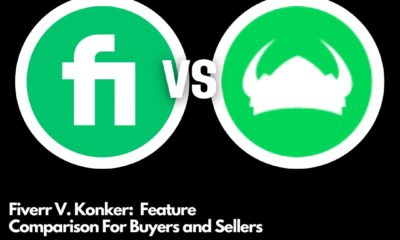Technology
Fiverr Vs. Guru – Feature Comparison For Freelancers And Clients.
Which freelance platform is the best fit for buyers and sellers?
Freelancing is one of the most popular careers right now. After the rise in remote work after 2020, many people are turning to freelance work due to flexible hours, work-from-home abilities, and the opportunity to work with a range of different clients.
Back in the day, it could be difficult to find remote work or to find a freelancer to work with. But now, there are many different sites and platforms designed to help connect freelancers to clients directly, without having to endlessly scroll.
Today, we will be taking a look at two of these platforms, Fiverr and Guru.
Fiverr
What is Fiverr?
Fiverr is a freelance platform designed to help connect you to any type of service you can imagine – from organizing your social media to AI help, you can offer or purchase nearly anything on this site.
After gaining media attention in recent years, the platform has definitely become the number one way to find digital services in 2023. In 2022, the site made an annual revenue of over 330 million USD.
How does Fiverr work for freelancers?
Fiverr allows you to start posting gigs the second you sign up for their platform. ‘Gigs’ are what Fiverr calls the types of services you will be creating.
While creating your gig, make sure to include positive keywords, finished products of your service, and other important factors, such as your rate and how quickly you can get the service completed.
Below is an example of a Level 2 Seller and their gig.
As you can see, they included helpful information such as why you should choose them as a freelancer, what experience they have, and all services available.
You can also include different packages that will raise in price depending on the type of service you’re offering.
For example, your basic package will be the least expensive option, but come with the least amount of features, such as 14 day delivery time and one revision provided. On the other hand, the premium package will be the most expensive, but come with many more features, such as more revisions and a quicker delivery time.
As you move forward on the website as a freelancer, Fiverr provides different levels that will be shown on your profile. The levels are New Seller, Level 1, Level 2, and Top Rated Seller.
You automatically start as a New Seller. New Seller’s can post up to 7 gigs, and add 2 extra services to each gig.
Once you are an active seller for at least 60 days, complete at least 10 orders, earn $400 or more, maintain a 4.7-star rating over 60 days, deliver a 90% response rate score over 60 days, score a 90% order completion rate over 60 day, achieve a 90% on-time delivery score over 60 days, and receive no warnings over 30 days, you can move up to Level 1. This allows you to create 10 gigs and add 4 extra services. The higher your level, the more likely clients are to purchase services from you.
Below are some of the requirements to get to Level 2 Seller and Top Rated Seller.
Fiverr automatically takes 20% of all your earnings. That means you will receive 80% of your profits.
How does Fiverr work for clients?
You can easily switch between being a freelancer or a client on Fiverr. Instead of posting gigs, you can search out exactly what type of service you’re looking for and purchase the service from a freelancer.
If you are scrolling through gigs and can’t find one that fits your exact project, you can also submit a request and get matched with a freelancer through Fiverr directly.
Include details such as what your project is, and your timeline and budget, and Fiverr will do its’ best to put you in contact with a Freelancer perfect for the job. You can discuss directly with the freelancer to find a price and a plan that works for both of you.
For buyers, there is an automatic service fee of 5.5% on all orders.
Guru
What is Guru?
Guru is another freelance site that hosts over 800,000 employers worldwide and over 3 million users. The site claims to have paid over $250 million to freelancers since its’ creation in 1998, and has offices in both Pennsylvania and India.
The site has access to freelancers in categories such as programming and development, sales and marketing, design and art, and more.
How Does Guru Work for Freelancers?
Signing up for Guru is free. Once you sign up, you can start browsing job postings from potential clients and give quotes to the projects you’re interested in working with.
When your profile is complete, clients can look at your profile and decide if they want to work with you on the project.
Below are some examples of successful profiles that clients can look through.
Once you both agree to work together, you can finalize an agreement on Guru directly so that you are protected by the site. If either party falls through, you know you won’t be scammed.
How will you get paid?
You can use SafePay, which means the client will automatically put money into their account before the project is started so that you can guarantee payment. You can also use secure payment platforms like PayPal or direct deposit.
While you can use Guru for free, there are paid memberships you can subscribe to for additional features that will help you gain more jobs, boost your rankings, and pay less in fees. Below is an example of the different memberships you can choose from.
As you can see, with the free membership, you will be charged up to 9% on every paid invoice. Whereas when you are an executive member, at nearly $50 USD a month, you will only be charged a 5% fee.
How does Guru Work For Clients?
You can post a job for free with Guru – simply post a job title, describe the job, and discuss what type of payment the freelancer will receive. Hourly, fixed price, or you’re open to either.
Here is where you can also list the type of category your project will fall under.
Below are some examples of finished job postings.
Guru stays completely free for employers – definitely an upside compared to other freelancer programs.
With the free membership, you can post unlimited jobs, request quotes from freelancers, utilize SafePay, and will pay only a 2.9% fee on the invoice amount.
Guru also has a feature called WorkRooms which allows you to organize your team more efficiently. If you are using several freelancers, WorkRooms can help you assign jobs, manage files, communication, and payment all in one space.
Which freelance platform is best?
Since Fiverr has the brand recognition from the media reception in recent years, as well as many more users, this may be the best option for those looking to start in the freelance field, especially if you aren’t sure where to begin and don’t want to pay high membership costs. However, for more experienced freelancers, or for clients looking for freelancers, Guru is definitely more cost efficient for clients as they pay no membership fees. Guru also only takes 9% of freelancer’s final pay, as compared to Fiverr’s 20%.
Which freelance platform will you use? Do you use alternatives like UpWork or Freelancer? Let us know down below.





















